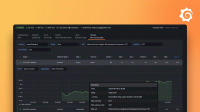Caution
Grafana Alloy is the new name for our distribution of the OTel collector. Grafana Agent has been deprecated and is in Long-Term Support (LTS) through October 31, 2025. Grafana Agent will reach an End-of-Life (EOL) on November 1, 2025. Read more about why we recommend migrating to Grafana Alloy.
otelcol.exporter.otlphttp
otelcol.exporter.otlphttp accepts telemetry data from other otelcol
components and writes them over the network using the OTLP HTTP protocol.
NOTE:
otelcol.exporter.otlphttpis a wrapper over the upstream OpenTelemetry Collectorotlphttpexporter. Bug reports or feature requests will be redirected to the upstream repository, if necessary.
Multiple otelcol.exporter.otlphttp components can be specified by giving them
different labels.
Usage
otelcol.exporter.otlphttp "LABEL" {
client {
endpoint = "HOST:PORT"
}
}Arguments
otelcol.exporter.otlphttp supports the following arguments:
| Name | Type | Description | Default | Required |
|---|---|---|---|---|
metrics_endpoint | string | The endpoint to send metrics to. | client.endpoint + "/v1/metrics" | no |
logs_endpoint | string | The endpoint to send logs to. | client.endpoint + "/v1/logs" | no |
traces_endpoint | string | The endpoint to send traces to. | client.endpoint + "/v1/traces" | no |
The default value depends on the endpoint field set in the required client
block. If set, these arguments override the client.endpoint field for the
corresponding signal.
Blocks
The following blocks are supported inside the definition of
otelcol.exporter.otlphttp:
| Hierarchy | Block | Description | Required |
|---|---|---|---|
| client | client | Configures the HTTP server to send telemetry data to. | yes |
| client > tls | tls | Configures TLS for the HTTP client. | no |
| sending_queue | sending_queue | Configures batching of data before sending. | no |
| retry_on_failure | retry_on_failure | Configures retry mechanism for failed requests. | no |
| debug_metrics | debug_metrics | Configures the metrics that this component generates to monitor its state. | no |
The > symbol indicates deeper levels of nesting. For example, client > tls
refers to a tls block defined inside a client block.
client block
The client block configures the HTTP client used by the component.
The following arguments are supported:
| Name | Type | Description | Default | Required |
|---|---|---|---|---|
endpoint | string | The target URL to send telemetry data to. | yes | |
encoding | string | The encoding to use for messages. Should be either "proto" or "json". | "proto" | no |
read_buffer_size | string | Size of the read buffer the HTTP client uses for reading server responses. | 0 | no |
write_buffer_size | string | Size of the write buffer the HTTP client uses for writing requests. | "512KiB" | no |
timeout | duration | Time to wait before marking a request as failed. | "30s" | no |
headers | map(string) | Additional headers to send with the request. | {} | no |
compression | string | Compression mechanism to use for requests. | "gzip" | no |
max_idle_conns | int | Limits the number of idle HTTP connections the client can keep open. | 100 | no |
max_idle_conns_per_host | int | Limits the number of idle HTTP connections the host can keep open. | 0 | no |
max_conns_per_host | int | Limits the total (dialing,active, and idle) number of connections per host. | 0 | no |
idle_conn_timeout | duration | Time to wait before an idle connection closes itself. | "90s" | no |
disable_keep_alives | bool | Disable HTTP keep-alive. | false | no |
http2_read_idle_timeout | duration | Timeout after which a health check using ping frame will be carried out if no frame is received on the connection. | 0s | no |
http2_ping_timeout | duration | Timeout after which the connection will be closed if a response to Ping is not received. | 15s | no |
auth | capsule(otelcol.Handler) | Handler from an otelcol.auth component to use for authenticating requests. | no |
When setting headers, note that:
- Certain headers such as
Content-LengthandConnectionare automatically written when needed and values inheadersmay be ignored. - The
Hostheader is automatically derived from theendpointvalue. However, this automatic assignment can be overridden by explicitly setting aHostheader inheaders.
Setting disable_keep_alives to true will result in significant overhead establishing a new HTTP(s) connection for every request.
Before enabling this option, consider whether changes to idle connection settings can achieve your goal.
If http2_ping_timeout is unset or set to 0s, it will default to 15s.
If http2_read_idle_timeout is unset or set to 0s, then no health check will be performed.
By default, requests are compressed with gzip.
The compression argument controls which compression mechanism to use. Supported strings are:
"gzip""zlib""deflate""snappy""zstd"
If compression is set to "none" or an empty string "", no compression is used.
tls block
The tls block configures TLS settings used for the connection to the HTTP
server.
The following arguments are supported:
| Name | Type | Description | Default | Required |
|---|---|---|---|---|
ca_file | string | Path to the CA file. | no | |
ca_pem | string | CA PEM-encoded text to validate the server with. | no | |
cert_file | string | Path to the TLS certificate. | no | |
cert_pem | string | Certificate PEM-encoded text for client authentication. | no | |
insecure_skip_verify | boolean | Ignores insecure server TLS certificates. | no | |
include_system_ca_certs_pool | boolean | Whether to load the system certificate authorities pool alongside the certificate authority. | false | no |
insecure | boolean | Disables TLS when connecting to the configured server. | no | |
key_file | string | Path to the TLS certificate key. | no | |
key_pem | secret | Key PEM-encoded text for client authentication. | no | |
max_version | string | Maximum acceptable TLS version for connections. | "TLS 1.3" | no |
min_version | string | Minimum acceptable TLS version for connections. | "TLS 1.2" | no |
cipher_suites | list(string) | A list of TLS cipher suites that the TLS transport can use. | [] | no |
reload_interval | duration | The duration after which the certificate is reloaded. | "0s" | no |
server_name | string | Verifies the hostname of server certificates when set. | no |
If the server doesn’t support TLS, you must set the insecure argument to true.
To disable tls for connections to the server, set the insecure argument to true.
If reload_interval is set to "0s", the certificate never reloaded.
The following pairs of arguments are mutually exclusive and can’t both be set simultaneously:
ca_pemandca_filecert_pemandcert_filekey_pemandkey_file
If cipher_suites is left blank, a safe default list is used.
See the Go TLS documentation for a list of supported cipher suites.
sending_queue block
The sending_queue block configures an in-memory buffer of batches before data is sent
to the HTTP server.
The following arguments are supported:
| Name | Type | Description | Default | Required |
|---|---|---|---|---|
enabled | boolean | Enables an in-memory buffer before sending data to the client. | true | no |
num_consumers | number | Number of readers to send batches written to the queue in parallel. | 10 | no |
queue_size | number | Maximum number of unwritten batches allowed in the queue at the same time. | 1000 | no |
When enabled is true, data is first written to an in-memory buffer before sending it to the configured server.
Batches sent to the component’s input exported field are added to the buffer as long as the number of unsent batches doesn’t exceed the configured queue_size.
queue_size determines how long an endpoint outage is tolerated.
Assuming 100 requests/second, the default queue size 1000 provides about 10 seconds of outage tolerance.
To calculate the correct value for queue_size, multiply the average number of outgoing requests per second by the time in seconds that outages are tolerated. A very high value can cause Out Of Memory (OOM) kills.
The num_consumers argument controls how many readers read from the buffer and send data in parallel.
Larger values of num_consumers allow data to be sent more quickly at the expense of increased network traffic.
retry_on_failure block
The retry_on_failure block configures how failed requests to the HTTP server are
retried.
The following arguments are supported:
| Name | Type | Description | Default | Required |
|---|---|---|---|---|
enabled | boolean | Enables retrying failed requests. | true | no |
initial_interval | duration | Initial time to wait before retrying a failed request. | "5s" | no |
max_elapsed_time | duration | Maximum time to wait before discarding a failed batch. | "5m" | no |
max_interval | duration | Maximum time to wait between retries. | "30s" | no |
multiplier | number | Factor to grow wait time before retrying. | 1.5 | no |
randomization_factor | number | Factor to randomize wait time before retrying. | 0.5 | no |
When enabled is true, failed batches are retried after a given interval.
The initial_interval argument specifies how long to wait before the first retry attempt.
If requests continue to fail, the time to wait before retrying increases by the factor specified by the multiplier argument, which must be greater than 1.0.
The max_interval argument specifies the upper bound of how long to wait between retries.
The randomization_factor argument is useful for adding jitter between retrying agents.
If randomization_factor is greater than 0, the wait time before retries is multiplied by a random factor in the range [ I - randomization_factor * I, I + randomization_factor * I], where I is the current interval.
If a batch hasn’t been sent successfully, it is discarded after the time specified by max_elapsed_time elapses.
If max_elapsed_time is set to "0s", failed requests are retried forever until they succeed.
debug_metrics block
The debug_metrics block configures the metrics that this component generates to monitor its state.
The following arguments are supported:
| Name | Type | Description | Default | Required |
|---|---|---|---|---|
disable_high_cardinality_metrics | boolean | Whether to disable certain high cardinality metrics. | true | no |
disable_high_cardinality_metrics is the Grafana Agent equivalent to the telemetry.disableHighCardinalityMetrics feature gate in the OpenTelemetry Collector.
It removes attributes that could cause high cardinality metrics.
For example, attributes with IP addresses and port numbers in metrics about HTTP and gRPC connections are removed.
Exported fields
The following fields are exported and can be referenced by other components:
| Name | Type | Description |
|---|---|---|
input | otelcol.Consumer | A value that other components can use to send telemetry data to. |
input accepts otelcol.Consumer data for any telemetry signal (metrics,
logs, or traces).
Component health
otelcol.exporter.otlphttp is only reported as unhealthy if given an invalid
configuration.
Debug information
otelcol.exporter.otlphttp does not expose any component-specific debug
information.
Example
This example creates an exporter to send data to a locally running Grafana Tempo without TLS:
otelcol.exporter.otlphttp "tempo" {
client {
endpoint = "http://tempo:4317"
tls {
insecure = true
insecure_skip_verify = true
}
}
}Compatible components
otelcol.exporter.otlphttp has exports that can be consumed by the following components:
- Components that consume OpenTelemetry
otelcol.Consumer
Note
Connecting some components may not be sensible or components may require further configuration to make the connection work correctly. Refer to the linked documentation for more details.



